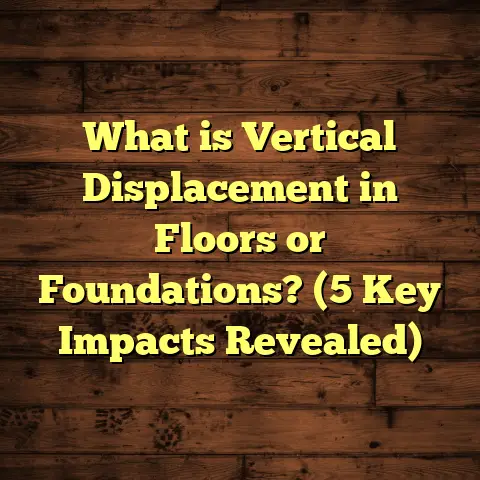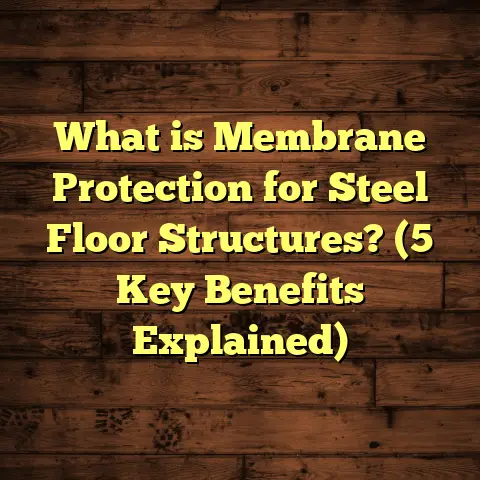What is HDPC Flooring? (5 Key Benefits You Must Know!)
Imagine your home’s floor like the foundation of a ship braving the rough seas. It needs to be strong enough to endure waves of wear and tear, yet flexible enough to adapt to changing conditions without cracking under pressure. Over the years, I’ve installed countless floors, but few materials have impressed me quite like HDPC flooring. It’s a solution that combines resilience with style and practicality in a way that few others can match.
If you’re wondering what HDPC flooring is and why it’s becoming such a popular choice for homeowners, business owners, and contractors alike, I’m here to walk you through everything you need to know. By the time you finish reading, you’ll understand not just what HDPC flooring is, but also why it might be the perfect fit for your next project.
What is HDPC Flooring?
To get started, let me define HDPC flooring in simple terms. HDPC stands for High-Density Polymer Core flooring. It’s a type of engineered flooring that uses a dense polymer core as its base. This core is made from synthetic materials such as polyvinyl chloride (PVC) or wood polymer composite (WPC), giving it remarkable strength and moisture resistance compared to traditional flooring materials.
Unlike hardwood or laminate floors, which rely on natural wood fibers or wood-based cores, HDPC’s polymer core gives it enhanced stability and durability. This makes it an excellent choice for areas prone to humidity or heavy foot traffic.
The Manufacturing Process: Behind the Scenes of HDPC Flooring
Understanding how HDPC flooring is made helps explain its unique properties. The process typically involves several key steps:
- Material Blending: The foundation of HDPC flooring is a polymer mixture, often PVC combined with plasticizers and stabilizers. Sometimes recycled materials are added to improve sustainability. This blend is heated and mixed until fully integrated.
- Extrusion: The molten polymer mixture is extruded through a die to create sheets of uniform thickness. These sheets form the high-density core of the flooring planks.
- Design Printing: A high-resolution photographic layer is printed on top of the core sheet using advanced digital printing technology. This layer mimics natural textures like wood grain, stone veining, or ceramic patterns.
- Wear Layer Application: To protect the design layer, a transparent wear layer is laminated over it. This layer is typically made of polyurethane or aluminum oxide and ranges from 0.3mm to 0.7mm thick.
- Cutting and Profiling: The laminated sheets are cut into individual planks or tiles of various sizes. Each plank is then profiled with precise tongue-and-groove edges for an easy click-lock installation system.
- Quality Control: Before packaging, each batch undergoes rigorous testing for thickness consistency, wear resistance, water absorption, and fire safety compliance.
Because the core is synthetic and manufactured under controlled conditions, HDPC flooring offers consistent performance that natural wood or laminate floors often struggle to match.
Technical Specifications of HDPC Flooring
Here’s a detailed look at the typical specifications you’ll find with HDPC floors:
| Specification | Details |
|---|---|
| Core Material | High-density PVC or wood polymer composite |
| Density | Around 1,100 kg/m³ or higher |
| Thickness | Usually 6mm to 8mm |
| Wear Layer Thickness | 0.3mm to 0.7mm (polyurethane or aluminum oxide) |
| Water Resistance | Core is 100% waterproof |
| Installation Type | Click-lock or glue-down |
| Fire Resistance | Complies with ASTM E648 Class 1 standards |
| Warranty | Often 15-30 years depending on manufacturer |
| VOC Emissions | Low VOC / Green-certified options available |
My Journey with HDPC Flooring: Real-Life Experiences
Let me share a bit about my own experiences working with HDPC flooring over the years. Early in my flooring career, I mostly installed hardwood and laminate floors. While hardwood offered timeless elegance, it was vulnerable to moisture damage and required regular maintenance. Laminate was easier on budgets but often warped or chipped after a few years.
I first encountered HDPC flooring about five years ago when a client approached me with a unique challenge: they wanted wood-look floors in their coastal home’s kitchen and bathroom areas—but nothing that would swell or peel with constant humidity exposure.
After recommending and installing HDPC planks with a beautiful oak grain finish, I was amazed at how well the floor held up even after months of spills, humidity fluctuations, and everyday wear from kids and pets.
Since then, I’ve used HDPC flooring on multiple projects including:
- A commercial café with heavy foot traffic
- A rental property needing durable floors that withstand tenant abuse
- A sunroom where moisture resistance was critical
- A boutique hotel lobby requiring both aesthetics and slip resistance
The consistent feedback? The floors look great after years of use and need very little upkeep compared to traditional materials.
Why Choose HDPC Flooring? Five Benefits You Should Know
You might be asking yourself: what makes HDPC flooring stand out? Here are five key benefits that convinced me—and many others—to recommend this material over others.
1. Superior Water Resistance—No More Swelling or Warping!
One of the biggest headaches with wood-based floors has always been moisture damage. Water spills, steam from cooking, or even humidity can cause planks to swell, warp, or develop mold underneath.
HDPC flooring tackles this problem head-on because its core is made from high-density polymers that don’t absorb water at all. This means:
- No swelling when exposed to water
- No warping from humidity changes
- Resistance to mold and mildew growth
To give you an idea of how impressive this is: independent lab tests have shown that HDPC planks submerged in water for over 72 hours show no visible signs of damage or dimensional change.
For homeowners in humid climates or anyone who wants floors in kitchens, bathrooms, basements, or laundry rooms that won’t degrade quickly—HDPC’s waterproof core is a game changer.
2. Outstanding Durability That Withstands Heavy Traffic
If you’ve ever installed floors in commercial spaces or busy family homes, you know how quickly some materials show wear and tear.
HDPC flooring features a tough wear layer that resists scratches, scuffs, stains, and dents better than most laminate or vinyl options.
In fact, industry-standard abrasion tests (like the Taber test) rate HDPC wear layers to withstand more than 25,000 cycles before showing significant surface degradation. To put that in perspective:
- Laminate floors typically last around 10,000 cycles in the same test
- Hardwood varies widely based on wood species but can dent more easily
- Vinyl generally has good wear resistance but may scratch more visibly
This durability means fewer repairs and replacements over time—something I’ve seen firsthand in rental properties where tenants aren’t always gentle on floors.
3. Dimensional Stability for All Climates
Floors expanding or contracting with temperature changes can cause gaps between planks or buckling issues—problems I’ve dealt with repeatedly installing traditional wood floors.
HDPC’s dense polymer core resists dimensional changes caused by heat or moisture variations much better than natural wood or fiberboard cores in laminate.
For example, a study comparing dimensional changes showed HDPC planks expanding less than 0.1% under extreme humidity changes—while laminate expanded up to 0.3%.
This stability means your floor stays flat and tight year-round without annoying gaps or unevenness developing.
4. Simple Installation Saves Time and Money
I’ve always appreciated flooring options that make installation easier—especially for DIYers or contractors looking to reduce labor time.
Most HDPC flooring comes with a “click-lock” system where planks snap together without glue or nails. This makes:
- Faster installation (often 30-50% quicker than glue-down methods)
- Easier DIY projects for homeowners with basic tools
- Cleaner installations with less mess
I remember helping a friend install nearly 500 square feet of HDPC floor in just two days over a weekend—no special adhesives required.
The planks can often be installed over existing hard surfaces like vinyl or tile too, reducing prep work.
5. Eco-Friendly Options for Conscious Consumers
You might be surprised to learn some HDPC floors are manufactured with sustainability in mind.
Many manufacturers now incorporate:
- Recycled polymers to reduce waste
- Low-VOC adhesives and finishes for better indoor air quality
- Certifications like FloorScore® or GREENGUARD® Gold confirming low emissions
Market research shows demand for eco-conscious flooring options rising steadily among homeowners who want durable floors without compromising environmental responsibility.
From my conversations with suppliers and clients focused on green building practices, HDPC’s potential as a sustainable choice continues growing alongside its performance benefits.
Breaking Down the Cost: Is HDPC Flooring Worth It?
Let’s talk numbers because cost matters when you’re planning any home improvement project.
HDPC flooring usually falls somewhere between laminate and premium vinyl plank pricing—often slightly more expensive than laminate but less than high-end hardwood.
Here’s an approximate cost breakdown per square foot including materials and labor (varies by region):
| Flooring Type | Average Cost (Materials + Installation) |
|---|---|
| Laminate | $3 – $7 |
| Vinyl Plank | $4 – $8 |
| HDPC Flooring | $5 – $9 |
| Hardwood | $8 – $15 |
While the upfront cost may be higher than laminate or vinyl, remember you’re investing in:
- Longer lifespan
- Fewer repairs/replacements
- Enhanced moisture resistance reducing damage-related costs
I’ve helped clients see savings over time because they avoided costly water damage repairs common with other floor types in damp environments.
What About Design Options? Can HDPC Flooring Look Good?
Absolutely! One of the biggest misconceptions about synthetic core floors is that they look cheap or fake compared to real wood or tile.
Thanks to advances in digital printing technology and surface texturing techniques used during manufacturing, HDPC flooring offers an impressive range of realistic designs including:
- Various hardwood species (oak, walnut, hickory)
- Exotic wood grains
- Stone and marble patterns
- Ceramic tile looks
- Rustic distressed finishes
You can pick finishes that suit everything from classic traditional homes to modern urban lofts.
In fact, some of my favorite installs involved mixing several patterns to create unique aesthetics—like pairing weathered oak planks with slate-look tiles in adjacent rooms.
Plus, because the surface textures are embossed to closely mimic real wood grain or stone surfaces, they feel authentic underfoot—not plasticky like older vinyl options.
Installation Tips from My Experience
If you decide to go with HDPC flooring, here are some practical tips I’ve learned over multiple installs:
- Acclimate the Planks: Though HDPC is stable, letting your planks sit in the room for 48 hours before installation helps avoid minor expansion/contraction issues.
- Use Underlayment: For soundproofing and added comfort underfoot, use a quality foam underlayment compatible with click-lock systems.
- Check Subfloor Conditions: Make sure subfloor is clean, dry, and level within manufacturer tolerances.
- Leave Expansion Gaps: Even though expansion is minimal, leave recommended gaps around edges (usually 1/4 inch).
- Avoid Sharp Objects: While tough, avoid dragging heavy furniture with sharp legs directly on the floor.
Following these guidelines will help your floor look great and last longer.
Common Questions About HDPC Flooring
Q: Can HDPC flooring be installed over radiant heating?
A: Yes! Due to its stability and synthetic core, many HDPC products are compatible with underfloor heating systems—just check specific manufacturer recommendations.
Q: Is it suitable for commercial spaces?
A: Definitely. Many businesses choose HDPC for lobbies, retail shops, cafés due to durability and ease of maintenance.
Q: How do I clean HDPC floors?
A: Regular sweeping/vacuuming plus damp mopping with mild cleaners works well. Avoid harsh chemicals or abrasive scrubbers.
Q: Can damaged planks be replaced?
A: Yes. Thanks to click-lock installation, individual planks can usually be removed and replaced without disturbing entire floors.
Case Study: A Commercial Café’s Success Story
One project that stands out was a busy café downtown where owners wanted upscale wood-look floors without maintenance headaches.
They chose a dark walnut HDPC plank with textured finish for slip resistance. After 18 months:
- Floors showed minimal wear despite heavy daily traffic
- Cleaning was quick with no staining from coffee spills
- Staff reported increased safety due to non-slip surface
- Owners saved thousands by avoiding regular floor repairs common before
This real-world example highlights how HDPC combines performance and aesthetics effectively in demanding commercial environments.
Looking Ahead: The Future of HDPC Flooring
Flooring technology continues advancing rapidly. Manufacturers are experimenting with even tougher coatings, improved eco-friendly materials, and wider design choices for polymer core products like HDPC.
From what I see working closely with suppliers and clients,
HDPC flooring will keep gaining popularity as people seek reliable yet attractive floors requiring minimal upkeep—especially as urban living spaces become more humid and multi-functional.
Wrapping Up My Thoughts on HDPC Flooring
After all these years installing floors across diverse settings—from cozy homes to bustling businesses—I’m confident that HDPC flooring offers one of the best combinations of durability,
waterproofing,
style,
and affordability on the market today.
Whether you’re renovating a bathroom,
building out an office,
or outfitting a rental property,
HDPC’s high-density polymer core gives you peace of mind against moisture damage,
heavy wear,
and installation hassles that often plague other floor types.
If you want advice on specific brands,
installation methods,
or cost estimates tailored to your project,
just ask!
Ready to explore options? Tools like FloorTally can help calculate local material and labor costs accurately so you can budget smartly before making a decision.
Feel free to reach out anytime if you want personalized recommendations based on your space’s unique needs!
This completes the comprehensive guide on HDPC flooring—lasting strength beneath your feet so your space stays beautiful for years to come!





